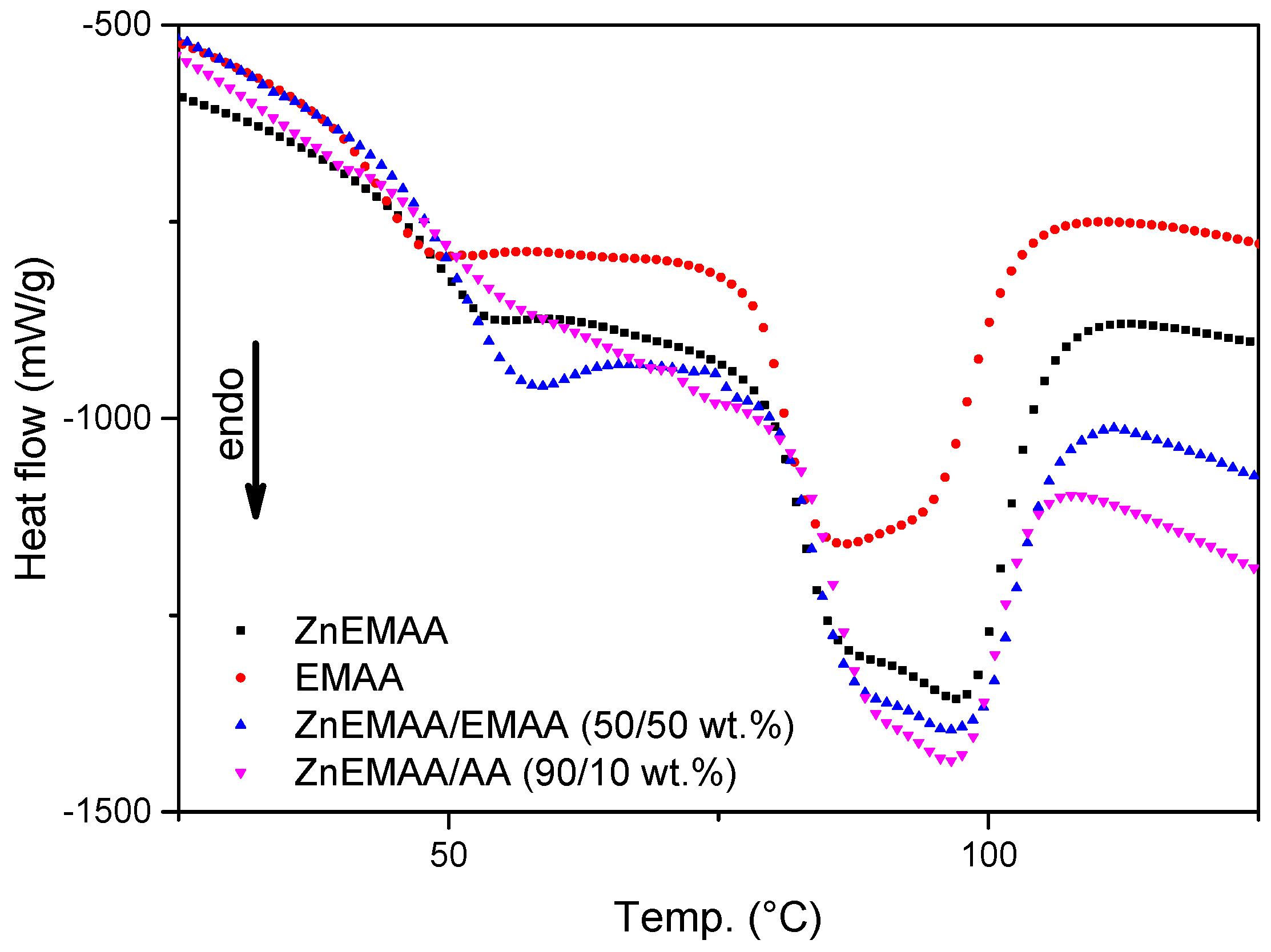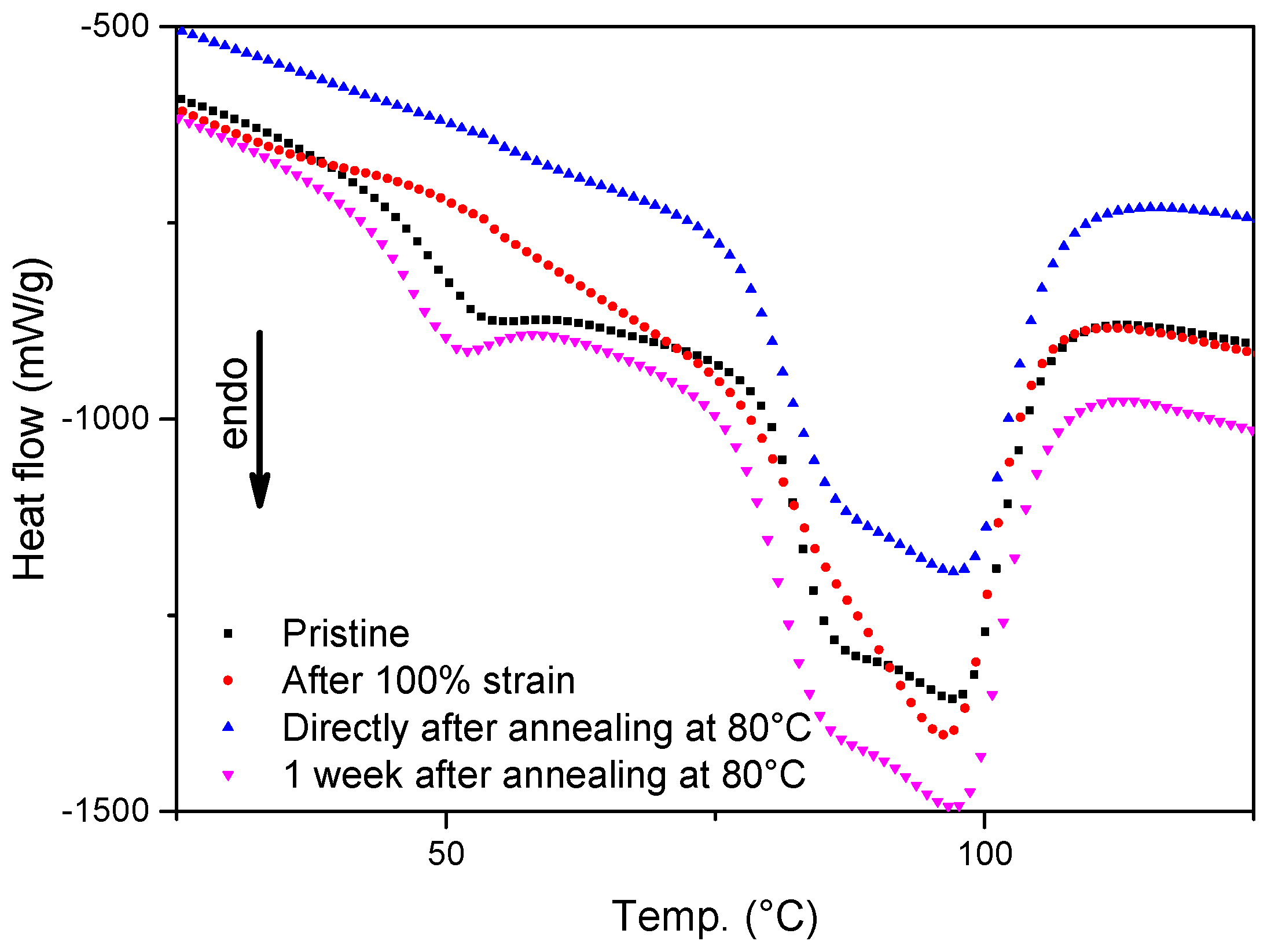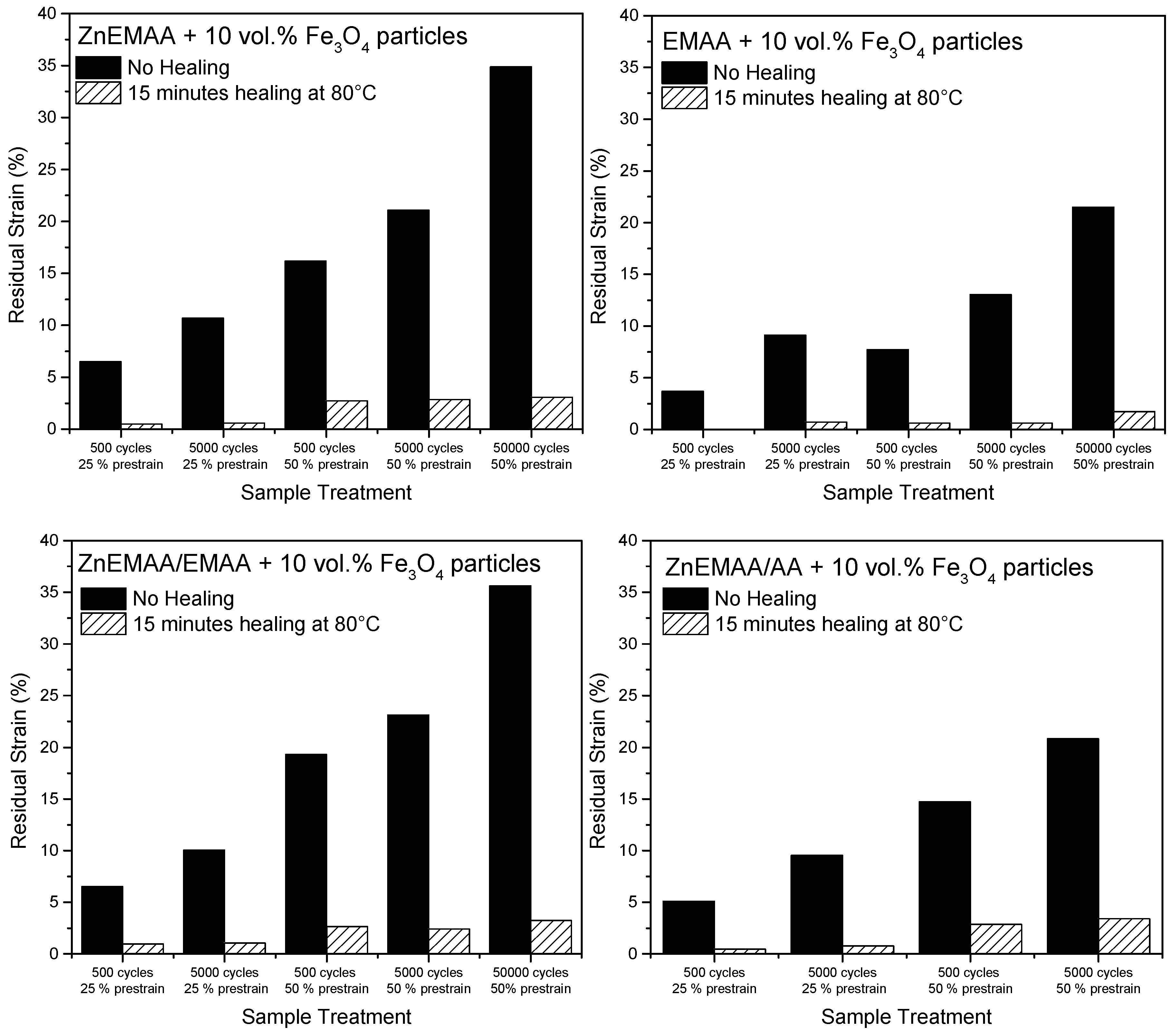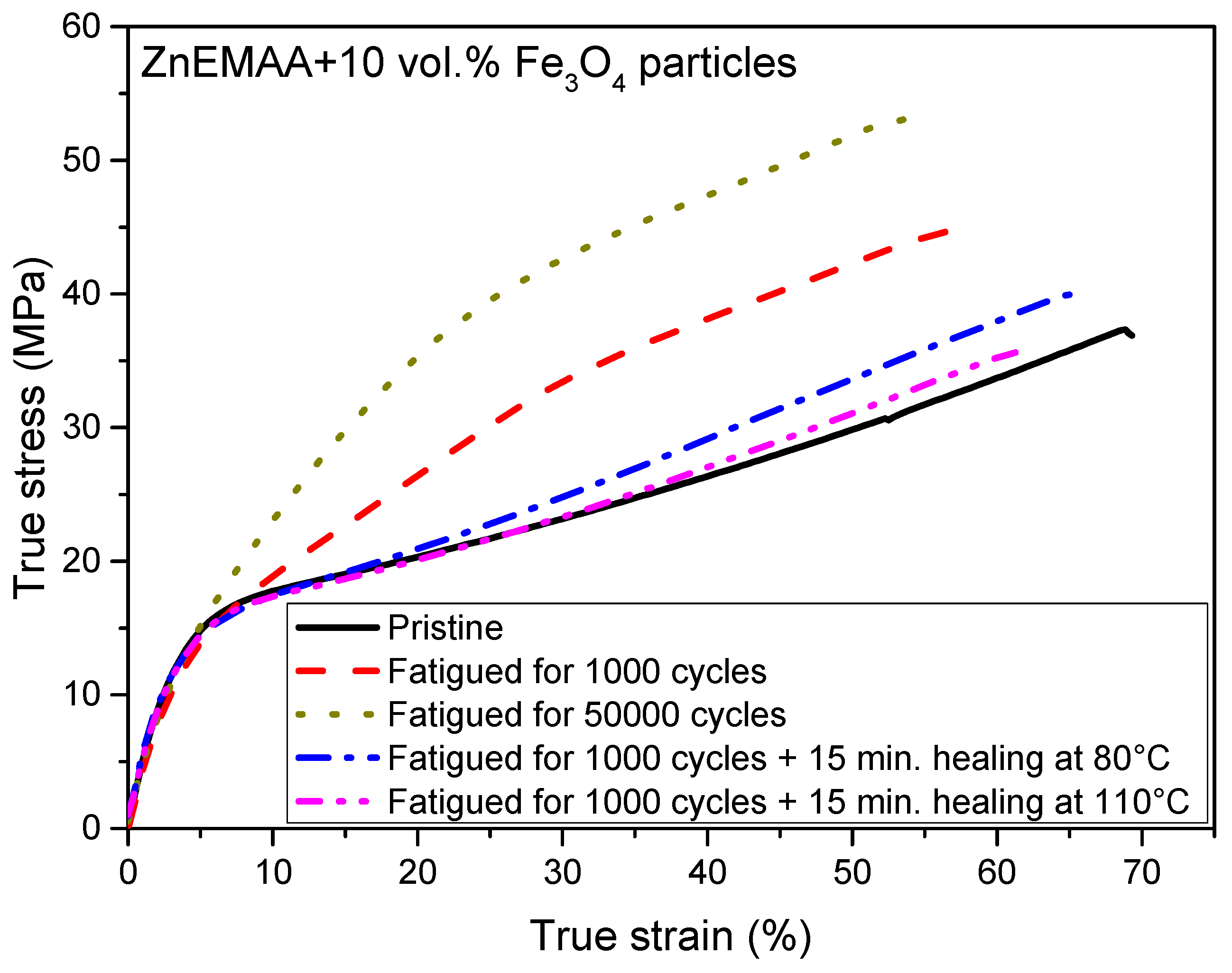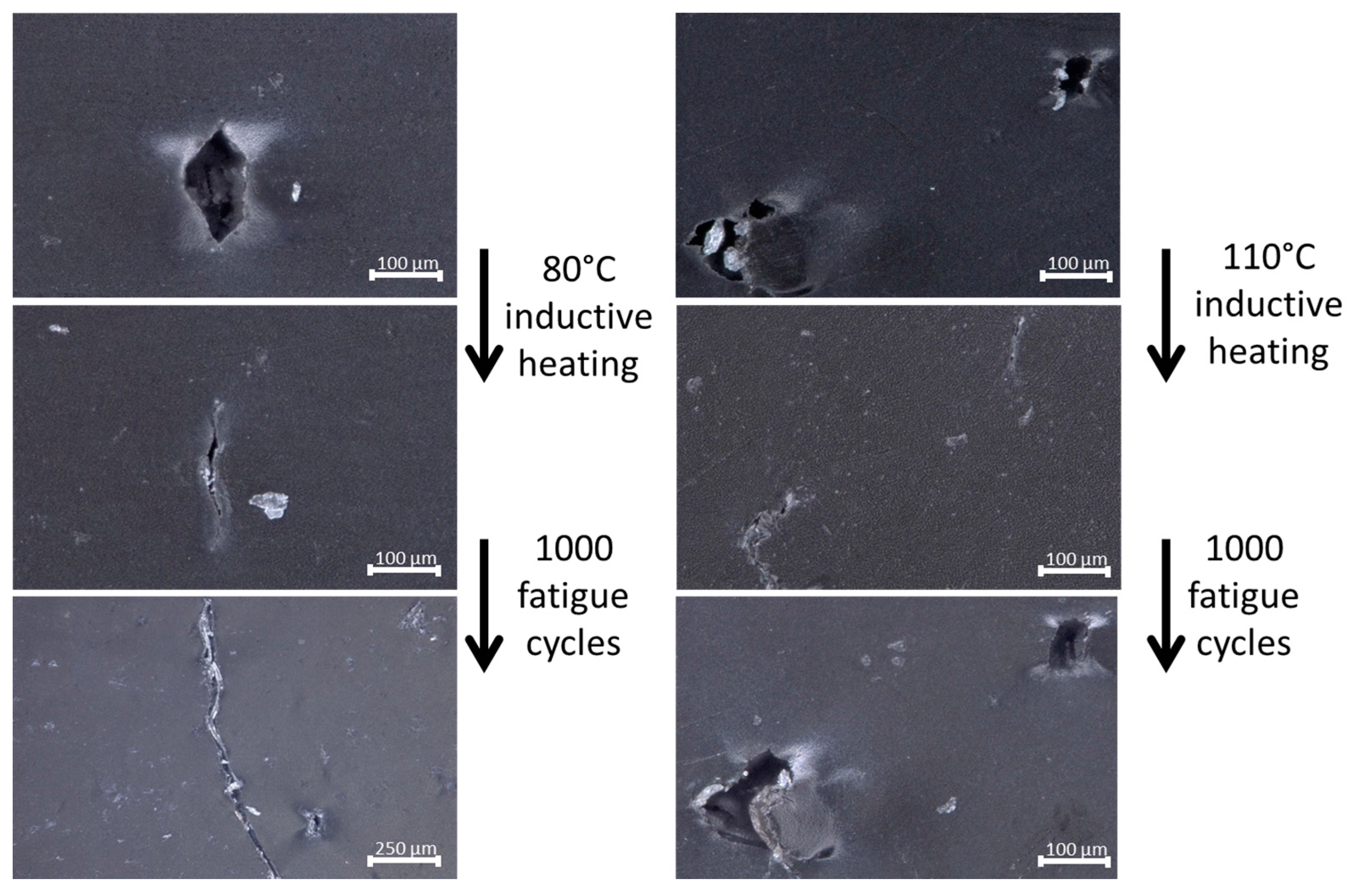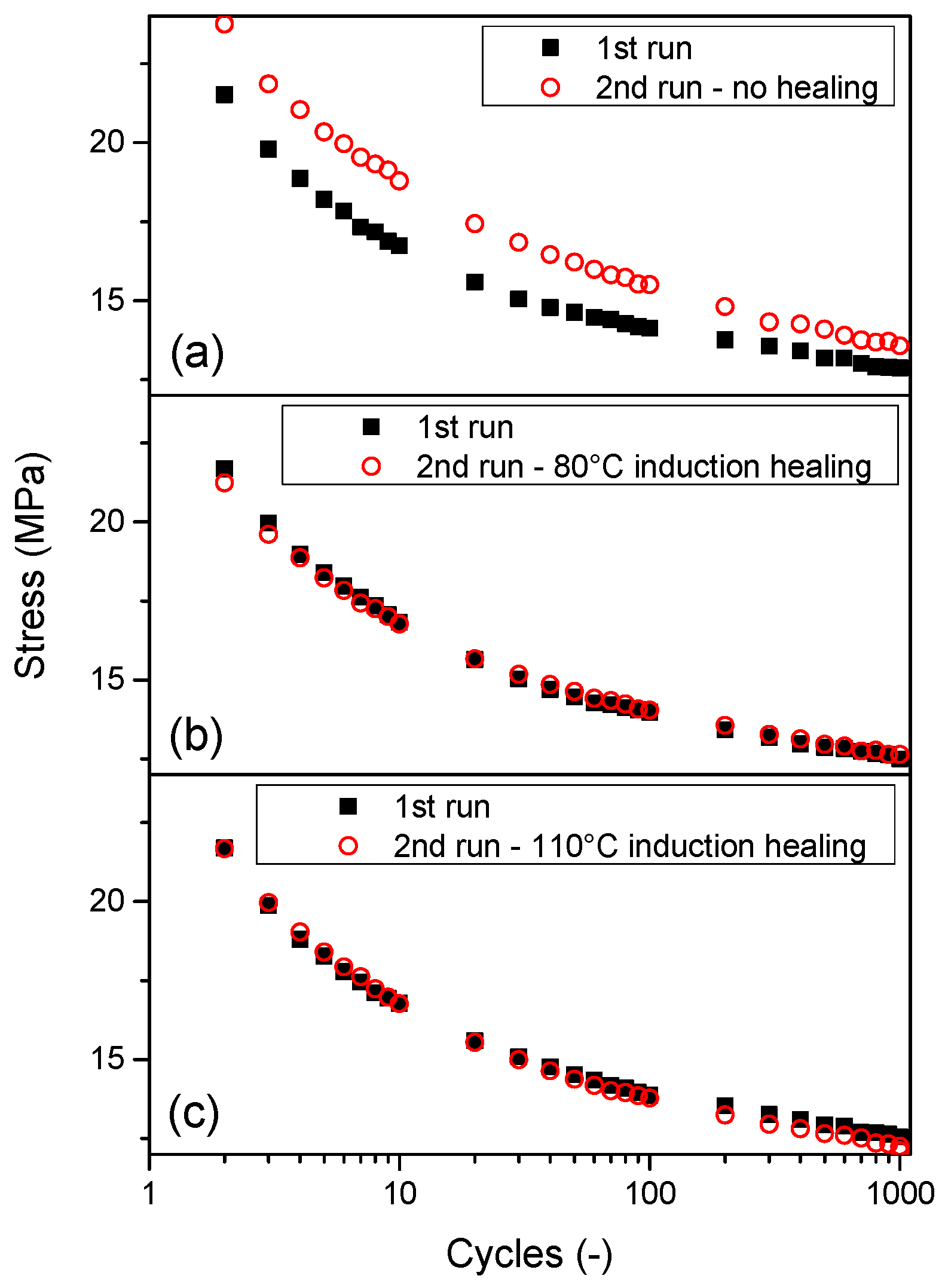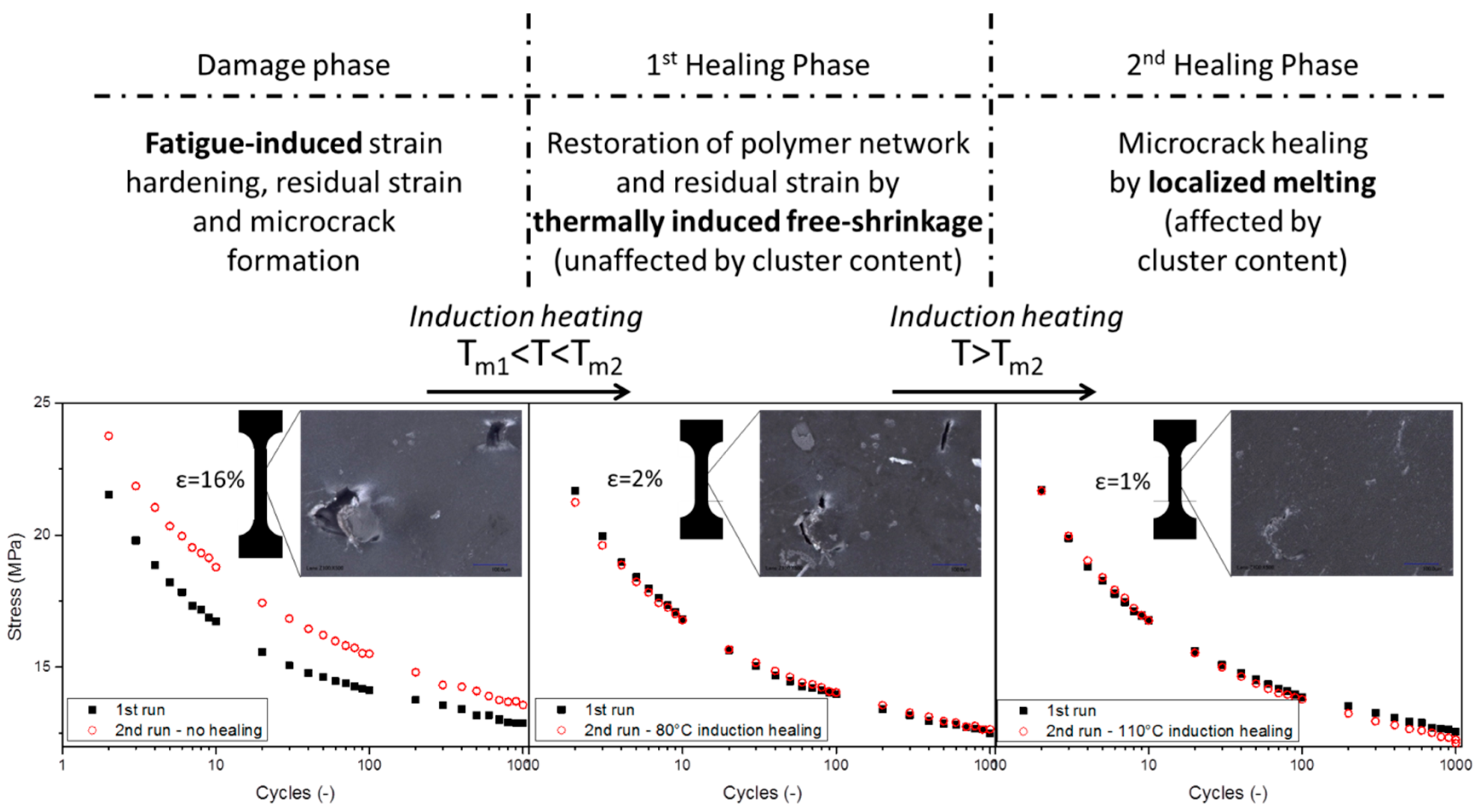1. Introduction
Polymer based composites are susceptible to many different types of mechanical damages which reduce their reliability and potentially decreases the overall lifetime of the material. By implementation of self-healing technologies the overall lifetime of polymer composites can be prolonged [
1,
2]. Within self-healing composites, most attention so far has been on extrinsic healing strategies where an external (liquid) healing agent capable of restoring either the matrix or the filler-matrix interface is encapsulated and embedded in the matrix [
3,
4,
5]. The mechanism certainly works but there are many issues still to be resolved. Even when solved, the fact remains that the healing reaction locally works only once and this is a major shortcoming [
2]. The use of intrinsically healing polymer matrices in such composites is considered to be more optimal because it has the potential of an infinite amount of healing cycles. Additionally, intrinsic healing leaves the optimized macroscopic fiber and ply architecture required for high level mechanical properties unaffected [
2,
6,
7].
Ionomers are among the most frequently studied polymer matrices for intrinsic self-healing particulate [
8,
9] or fiber reinforced composites [
10]. Ionomers have pendant acid groups distributed along the polymer backbone that are neutralized by ionic metal salts. These ionic groups have the tendency to form ionic clusters which create additional physical crosslinks within the polymer network [
7]. Ionomers have proven to be capable of restoring mechanical stability by healing of ballistic impact damage using a combination of shape recovery (sometimes called “shape memory”) and re-bonding across former damage site surfaces [
11,
12,
13,
14,
15]. The combination of the shape recovery effect and healing is not exclusive for ionomers but is also found in other polymer systems [
16,
17]. Besides healing after ballistic impact, which is investigated in the majority of self-healing ionomer studies, ionomers were also used to heal scratch damage [
18] and damage on composite toughening interlayers [
19]. The shape restoration of the polymer after puncture is made possible by the heat that is generated upon impact [
13,
14]. Strain recovery after deforming a polymer beyond its yield strain and subsequent heating is found to be typical for all semi-crystalline polyethylene-based polymers [
20,
21] and is attributed to the dominance of the decrease in the carbon bond angle over the overall carbon-carbon stretching when these polymers are deformed and heated consecutively [
22,
23]. Semi-crystalline ionomers were also reported to behave like traditional shape memory polymers by Dolog and Weiss [
20]. Since this form of thermal contraction after deformation does not correspond to the definition of shape memory polymers, the phenomenon was more accurately defined as free-shrinkage [
21] and we will use this terminology in the present work. Although there seems to be consensus about the mechanisms responsible for the restoration after polymer deformation, there is currently no general agreement on the role that the ionic clusters have on the healing effect [
24], i.e., the reformation of mechanical strength across a former crack.
As is the case for the majority of the intrinsically healing polymers, ionomers need a thermal stimulus to activate their healing behavior. This poses a direct disadvantage in future applications when the intended energy input has to be delivered from the nearby environment to the composite structure (e.g., by using an oven) [
25,
26,
27]. To overcome this disadvantage the energy input can be delivered locally from within the structure by making the ionomer suitable for inductive heating. In recent years this concept was explored by adding ferromagnetic particles to thermoplastic matrices [
28,
29,
30]. However, within these studies the thermoplastic material was simply melted and restored to its initial shape and lost all mechanical stability throughout the process. Recently, Hohlbein et al. demonstrated the concept of inductive healing in a new family of ionomers [
8]. Although this study showed the great potential of inductive heating for intrinsically self-healing polymers, their experimental ionomers still had rather low tensile properties.
In most studies on self-healing polymer composites, the research focused on the healing of damage after cutting or static overloading [
2,
7]. However, when a self-healing polymer is incorporated into a structural composite it is crucial to understand how the material behaves under dynamic fatigue loading and what types of damage are formed during the early stages of this process when the likelihood of complete healing is highest. Multiple studies describe the self-healing of fatigue induced mechanical damage in extrinsic healing composites [
31,
32,
33,
34,
35]. A recent study focused on the partial restoration of the functional piezoelectric properties in a lead zirconium titanite (PZT) ionomer composite [
9]. Nevertheless, to the best of our knowledge, the restoration of mechanical properties after fatigue in intrinsically self-healing polymers has not been investigated.
This study is the first investigation on the self-repair of mechanical properties of intrinsically self-healing polymer particulate composites after fatigue loading conditions. In this work, poly(ethylene-co-methacrylic acid) zinc ionomer/Fe3O4 nanoparticle composites were developed and subjected to different levels of fatigue loading. The initiated early stage fatigue damage was then healed upon localized heating of the particles by exposure of the composites to an alternating magnetic field. For a proper understanding of the mechanisms involved in the healing process a detailed thermo-mechanical investigation was performed on a set of poly(ethylene-co-methacrylic acid) based polymer blends with varying amounts of ionic clusters. Such an approach allowed the identification and separation of the two stages involved in the healing process: (i) the residual strain and network restoration; and (ii) the macroscopic crack sealing. A temperature window for the different stages of early stage damage healing in ionomer composites was thereby identified.
2. Materials and Methods
2.1. Materials
In order to evaluate the effect of cluster content, four different poly(ethylene-
co-methacrylic acid) (EMAA) zinc ionomer blends were prepared based on a previous study that investigated the role of free carboxylic content and cluster state on the healing of surface scratches [
18]. The four chosen blends resulted in polymer systems with high (Zn-EMAA), medium (Zn-EMAA/EMAA), no ionic groups (EMAA) and a blend where a relatively high amount of ionic clusters is neutralized (ZnEMAA/AA). In order to make the blends susceptible to inductive heating Fe
3O
4 particles (10 vol %, 50–100 nm, Sigma Aldrich, Zwijndrecht, The Netherlands) were added to the polymers based on previous healing studies. More information about the nature of the polymers and particles and full characterization can be found elsewhere [
8,
14,
20,
21,
29]. The selected blends were prepared with the following materials:
Zn-EMAA: Surlyn 9520®(Dupont™) containing 3.5 mol % methacrylic acid groups (MAA) out of which 71% were neutralized with Zn2+ ions.
EMAA: Nucrel 960® (Dupont™) containing 5.4 mol % of MAA groups.
Zn-EMAA/EMAA: 50/50 wt % blends of Zn-EMAA and EMAA.
Zn-EMAA/AA: 90/10 wt % blend of Zn-EMAA with adipic acid (AA) powder (Sigma Aldrich). In this blend the ionic clusters are destroyed by the adipic acid as is described by Varley et al. [
36].
Polymer composites were prepared by mixing all components (polymer pellets, particles and additives) using a twin screw mini-extruder. The extruder volume was 15 mL and a temperature of 200 °C and a torque of 50 rpm were applied. The residence time in the extruder was 5 min. After extrusion, the resulting products were compression moulded at 150 °C with a pressure of 4 MPa using a hot press resulting in 100 ± 5 µm freestanding films. Teflon films were used to separate the polymer films from the pressing plates. After moulding, the films were given a 15 min heat treatment at 80 °C in a preheated convection oven to equilibrate the thermal effects induced due to the rapid cooling after moulding. Films were stored at room temperature for at least 21 days to equilibrate the polymer microstructure prior to further testing. Dog-bone shaped specimens (ASTM D1708) were pressed from the prepared films.
2.2. Mechanical Testing
To study the deformation before and after free shrinkage, different levels of quasi-static strain (25%–100%) were applied to deform the polymer composites using an Instron Model 3365 universal testing systems equipped with a 1 kN load cell. Dog-bone micro-tensile specimens were stretched at 1 mm/s at room temperature. The average value of 3 experiments was reported.
Fatigue experiments were conducted on dog-bone shaped specimens at room temperature on an MTS 831 Elastomer test system equipped with a 1 kN load cell. The specimens were fatigue tested under different prestrain levels of 25% and 50% from which a sinusoidal waveform with an amplitude of 2.3% and a frequency of 1 Hz was employed. The amount of applied strain cycles ranged from 500 to 50,000. Full fracture tensile tests were performed on different Zn-EMAA specimens at different stages of the fatigue restoration process using the same equipment and conditions as for the deformation experiments. True stress and true strain were calculated from these tests via:
where, σ
T = true stress in MPa;
P = measured load in N;
A0 = Area of the cross-section of the dog-bone in mm
2; ε = engineering strain in percent; and ε
T = true strain in percent.
The tensile tests were performed 7 days after the fatigue and healing treatments which allows the polymer crystalline phases to fully recover prior to further testing.
2.3. Thermomechanical Testing
The effect of cluster content on the deformation that occurs during fatigue and the thermal contraction upon heating was investigated using a Perkin–Elmer Sapphire differential scanning calorimeter (DSC). Samples were heated and cooled between −50 °C and 150 °C at a rate of 20 °C/min under a nitrogen atmosphere.
To obtain a deeper understanding of the effect of the clusters on the self-healing mechanism, the macroscale network mobility of the non-particulate polymer blends was investigated by oscillatory shear rheology. Experiments were performed with a Haake Mars III rheometer. An 8 mm diameter (stainless steel) parallel plate geometry was used throughout. For all the samples, the polymer thickness was between 0.9–1.2 mm, and a constant shear strain γ of 1%, which was within the linear viscoelastic regime of the materials, was applied. Frequency sweep experiments between 102 and 10−2 Hz were performed at temperatures of 80 and 110 °C, with an isothermal hold for 20 min prior to each temperature step. The supramolecular bond lifetime (τb) at different temperatures was then calculated as inverse of the frequency at which the storage and loss moduli crossover in a frequency sweep experiment.
2.4. Thermally Induced Healing Process and Evaluation
Induction heating was applied for 15 min using a single-turn hairpin induction coil mounted on an Ambrell Easyheat device. The coil and specimen were separated by Teflon foil and the coupling distance was fixed at 1 mm. A frequency of 350 kHz and currents between 200 and 250 A were applied to reach the intended temperatures. Healing temperatures were selected based on the different thermal transitions of the polymer as shown in
Figure 1 and
Figure 2. As such, the selected healing temperatures are located below the secondary thermal transition (50 °C), in between the secondary transition and the overall melting of the polymer (80 °C) and above the overall melting of the polymer (100–110 °C). The specimen temperature upon inductive heating was monitored with a FLIR A655sc infrared camera. Since this method only detects the surface temperature of the ionomer composites, a COMSOL Multiphysics model was used to derive a relation between the measured surface temperature and the desired healing temperature within the bulk of the polymer sample. The used model is a stationary heat transfer model that correlates the measured surface temperature to the bulk healing temperature based on the thermal conductivity of the materials used. The model assumes a uniform distribution of particles within in cubic geometry corresponding to the used particle concentration of 10 vol %. Full information on the applied model (geometry, input parameters and calculations) can be found in
Supplementary Materials S1.
The closure and sealing of fatigue induced cracks was monitored with a digital microscope Keyence VHX2000 with a wide-range zoom lens (100×–1000× magnification). For the optimal illumination of the black surfaces the microscope was equipped with a OP-87229 short ring-light. The length of the samples before and after the thermal treatment was measured with a digital caliper and the residual strain was calculated based on this data.
4. Discussion
The optical microscopy images in
Figure 7 show a clear distinction between the closure and the sealing of fatigue induced cracks at the two healing temperatures. Although there seems to be an agreement on the mechanisms that are responsible for the contraction/closure [
20,
21], there is still an ongoing debate on the mechanism that is responsible for the crack sealing behavior of ionomers. The main discussion revolves around the low-temperature endotherm that is visualized by DSC in
Figure 2. The majority of studies on self-healing ionomers attribute this endotherm to a declustering of the ionic multiplets that are formed within the polymer microstructure as was described by Tadano et al. [
38]. It is reported that the declustering of these multiplets would create sufficient mobility for the polymer to heal at temperatures below the melting point [
8,
9,
14,
18,
37]. Another theory, posed by Eisenberg, describes the clusters of multiplets as a thermally stable phase with its own T
g that is higher than that of the surrounding non-ionic polymer phases. In their work, the origin of the low temperature endotherm is attributed to the crystallization of secondary crystals which form in between the primary crystal lattices over time [
39,
40]. In a recent publication by Kalista et al., it is reviewed that the most experimental evidence points towards the latter explanation for the thermomechanical behavior of ionomers. However, the precise mechanism responsible for the self-healing of ionomers is still under discussion [
24].
The results that are depicted in this work support the theory of Eisenberg over that of Tadano. A first indication is the fact that the DSC spectrum in
Figure 2 shows a low temperature endotherm for the EMAA polymer. Since there are no ionic clusters present in this polymer, the endotherm in this spectrum cannot be attributed to ionic multiplet formation within the structure. The presence of ionic clusters does, however, affect the formation of the low temperature endotherm and the secondary crystalline phase as is described by Loo et al. [
40]. In a similar fashion, the addition of adipic acid restricts the formation of this secondary crystalline phase as the corresponding endotherm peak around 50 °C in
Figure 1 flattens out completely. The results depicted in
Figure 3 also contradict the declustering concept since no crossover point between
G’ and
G” can be found at 80 °C [
8,
9,
37].
The fact that the low temperature endotherm disappears upon straining (
Figure 2) indicates that the molecular origin of this endotherm is not the sole explanation of the ionomer healing characteristics. The free-shrinkage behavior that is observed in this temperature range is most likely a result from the overall melting peak in the polymer which is very broad and starts at the onset of the low temperature endotherm. This statement is supported by the temperature dependency of the residual strain shown in
Figure 4. The smaller crystals melt at lower temperatures while the larger crystals remain crystallized and serve as a rigid internal structural entity as is also common in shape memory polymers [
20].
The thermal contraction is shown to be independent of the presence of clusters and the low-temperature endotherm, since
Figure 5 shows that the strain restoration after fatigue is clearly present for all compositions. As a matter of fact, these diagrams show that the contraction is highest in the non-ionic EMAA material as only in this material 100% restoration is observed after an applied strain of 50%. This is an indication that the presence of clusters might even restrict the mobility of the reforming secondary crystal phases of the polymer and thereby hindering the free-shrinkage capacity which is supported by the studies of Loo et al. [
40].
The optical microscopy images show that sealing of the fatigue induced microcracks only occurs when the ionomer is heated above 110 °C. This is in line with rheological data obtained in
Figure 3 and
Table 1. Here it is shown that the viscous component of the polymer does not get dominant over the elastic component before the overall melting point is reached. However, both thermal treatments lead to a full restoration of the original tensile behavior and fatigue response. This indicates that the polymer network is effectively repaired at temperatures below the melt temperature and that the formation and presence of microcracks does not directly affect the mechanical properties in the early stages of the damage formation. Nevertheless, the healing of the early stage damage will be necessary to extend the lifetime of the ionomer composites since these unsealed microcracks will eventually propagate into larger cracks, as was shown in
Figure 7. These propagated cracks will ultimately induce the destructive failure of the material as was observed for the 50,000-cycle fatigue treatment of the Zn-EMAA/AA blend.
The addition of the nanoparticles (10 vol %) was found to barely affect the overall tensile properties of the polymer. Full information on the impact of the nanoparticles on the tensile properties can be found in
Supplementary Materials S2. Besides a slight increase in yield strength and Young’s modulus, the main effect was an increased brittleness which is considered to have no effect on the applicability of the polymers since a tensile strain of at least 100% can still be achieved for the composites, as is depicted in
Figure 4. Nevertheless, it was found that the Fe
3O
4 particles induce microcracks that are not observed in the pure polymer films. Based on this, it could be reasoned that the particles only weaken the material and no additional mechanical benefits are obtained. However, since the microcracks do not affect the overall tensile properties and fatigue response of the polymer composite and can be fully healed by heating at 110 °C there is a zero net negative effect of the particles on the polymer behavior. On the other hand, the ferromagnetic particles allow the polymer to be healed by inductive heating which is crucial for larger composite structures that cannot be heated by external contact heating and therefore require internal heating.
Although the thermal behavior below the overall melting temperature is comparable for all investigated blends and therefore independent of cluster content, there is a clear difference in the region above the melt.
Table 1 shows different values for τ
b and
GN for the four polymer systems which can be explained by the presence of the ionic clusters. These create an additional phase in the polymer microstructure which has higher thermomechanical stability than the surrounding polymer phase. As a result, the non-ionic phase can flow in between the ionic clusters and thereby heal cracks and interfaces at a temperature above its melting point, while the overall polymer system maintains its required level of mechanical stability. When the cluster concentration is not high enough, the polymer will show melt flow and is therefore not considered to be a self-healing polymer. Based on the current observations it is possible to propose an ionomer healing temperature dependency scheme.
Figure 9 shows a two-step healing mechanism in which the thermally induced free-shrinkage is independent of cluster content and can be triggered by applying a temperature between the two main melting points of the polymer. At this temperature, the residual strain and the strain hardening that occur upon deformation are fully restored. Early stage damage in the form of fatigue induced microcracks can be subsequently healed by melting the polymer while the ionic clusters act as a stable phase providing sufficient mechanical properties for good healing conditions.
5. Conclusions
This work reports on the healing of early stage fatigue damage in poly(ethylene-co-methacrylic acid) based nanoparticulate composites upon localized inductive heating. It is found that there are three main damage modes that occur in the early stage of the fatigue process: residual strain, strain hardening and the formation of microcracks. Although the residual strain and strain hardening are a result of the nature of the polymer phase, the formation of microcracks is only observed upon the addition of the particulate phase.
It is demonstrated that healing of this early stage fatigue damage occurs in two different steps. Firstly, the deformation is restored by the free-shrinkage of the polymer. At temperatures below the melt temperature, the polymer network is healed and the fatigue induced strain hardening is reset. Secondly, only at temperatures above the melting point of the polymer phase, microcracks are sealed. It is shown that the thermally induced free-shrinkage in these polymers does not depend on the presence of ionic clusters, but that the ability to heal cracks in composite structures is reserved for ionomers that contain a sufficient amount of ionic clusters which guarantees an acceptable level of mechanical stability during healing. This implies that ionomers need to be thermally treated at above-the-melt temperatures in order to heal all the early stage damage that is induced upon fatigue loading.
